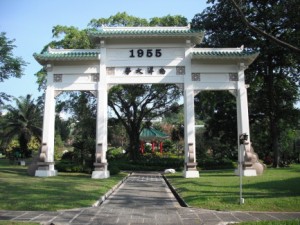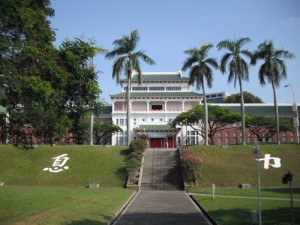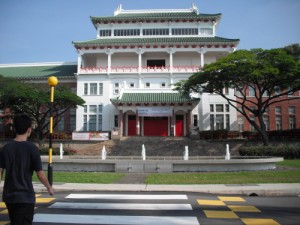The Hidden History of Nantah/Nanyang University
There are two traditional ornate gates to Nanyang Technological University, both inscribed in Chinese and with the date 1955. Neither is actually at an entrance to the university, but we’ll pass over that for now. They are both within hailing distance of the main campus and obviously point the way to the same direction. But they have two different names on them. The one outside the current campus is the gate to Nantah University. The one enshrined in the Yunnan Garden area of the campus is the gate to Nanyang U. So what’s the story here?
According to the cabbies, in the late 1940s Chinese Singaporeans wanted a university that would teach their children in Chinese. You may recall that until 1942 Singapore was ruled by the British, until it was overrun by Japanese soldiers on bicycles (a tale for another post). Once the Japanese were in place, they exterminated all the young Chinese men they could find, on the grounds that they could be spies for mainland Chinese – mainland China being another place where the Japanese failed to distinguish themselves for kindness and understanding in the 1940s.
Suffice it to say that Singapore’s Chinese population had had a very rough ride for 150 years, and they felt the need to get out of their rut and take control of their destiny through education. And education in a medium that was available to all of them, not just the elite who traded with the Brits. So they organized a donation campaign. Rickshaw pullers, taxi drivers, hawker-stall cooks, everyone contributed something: $30 or $40. And in 1955 Nantah University admitted its first students to a program in higher education in the Chinese language.
Great story, eh? But it gets complicated.
During the war many students and staff at Nantah had ached to help out their ancestral country, China, and before 1955 they had worked in China itself, in the army fending off the Japanese among other things. But once the Communist Party took over China official Chinese policy became to expel overseas Chinese, on the grounds of suspect loyalty. So Singapore-born Chinese were kicked out and returned to Singapore, where they turned to Nantah University to further their own educations or help their Singaporean compatriots.
In 1965 Singapore became independent of Malaysia and began to govern itself. When Lee Kwan Yew took power, a consistent thorn in his side were the Singaporean communists. He suspected that Nantah University was a hotbed of resistance and commie plotting, since there were so many people there who’d been evicted from the (communist) People’s Republic of China. So he shut it down in 1970, and instead created the National University of Singapore a couple of miles east – the flagship of Singaporean higher education, whose course offerings were to be English-only. This was in keeping with Lee’s general course of looking to the western world for Singapore’s main cultural and economic ties instead of to surrounding countries in Asia.
Only in 1980 did it become evident that NUS was insufficient for Singapore’s tertiary education needs, and so the grounds that had previously been Nantah University were converted to the brand-new Nanyang Technological University, dedicated to pumping out engineers at an astonishing rate. Every reminder of the old people’s university was expunged. But this erasure of history was NOT accepted with sheepish compliance – since Nantah had been founded by the people of Singapore themselves, deleting it from history was an unwise political move. So there are three remnants of Nantah University: the Yunnan Garden (containing the Nanyang Gate), the Chinese Heritage Center (which houses a permanent exhibit on what it means to be an Overseas Chinese), and, across the freeway and isolated in a park behnid the sports stadium, the Nantah Gate.
And nowhere on Nanyang University’s campus will you find any reference to the people’s university, Nantah. To find out about it, you need to ask a taxi driver. Or read this blog.


